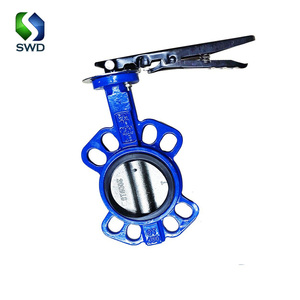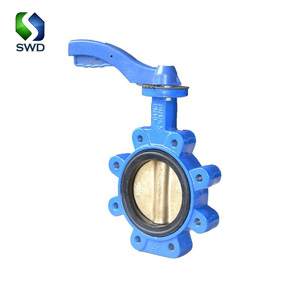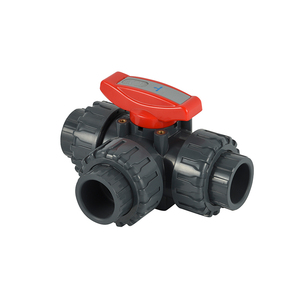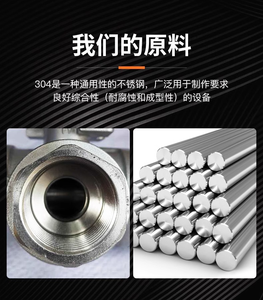
All categories
Featured selections
Trade Assurance
Buyer Central
Help Center
Get the app
Become a supplier

(5100 products available)

































Manual operated control valves are available in several types, each suitable for different applications and operational requirements. The following section elaborates on the various types of manual control valves.
Gate valves are mainly used to provide or prevent fluid flow within a piping system. These valves are opened or closed by a wedge-shaped metal gate, which moves up or down vertically. In a fully opened state, gate valves provide a straight passage for fluids, thus minimizing pressure loss. Conversely, in a closed position, gate valves offer a tight seal, preventing any leakage. Gate valves are most commonly used in applications requiring either fully opened or fully closed valve operation, such as in oil, water, and gas transmission systems.
Globe valves are well-suited for regulating fluid flow in industrial piping systems. The flow control feature is achieved through a movable disk element that can be positioned to partially block a port in the valve body. This port-blocking capability allows globe valves to precisely adjust the flow rate by changing the opening size, resulting in flow rate stability. Even though globe valves suffer from higher pressure drops than other valve types, their exceptional throttling capacity makes them appropriate for use in high-viscosity fluid applications. Furthermore, as a part of their design, globe valve construction enables efficient sealing against leaks.
Ball valves are quarter-turn valves with a hollow, perforated, and solid ball (a ball valve constituent) expanding and contracting fluid passage through the valve. When the ball's hole is aligned with the valve body, fluid flow is enabled. When the ball is turned 90 degrees, the solid part of the ball blocks fluid flow, thus providing valve closure. Their simple design allows for quick operation, and because they seal tightly when closed, ball valves are ideal for on-off control. They are extensively used in various industries due to their durability, retardant to leakage, and operational simplicity.
Butterfly valves are a type of quarter-turn valve characterized by a simple design, low cost, and lightweight components. They offer good performance in isolating or regulating fluid flow. A butterfly valve disk rotates perpendicular to the flow direction to open and parallel to close, allowing for efficient sealing against high-pressure systems. Even though butterfly valves provide quick operation and reasonable cost, their pressure drop and flow rate limitation compared to other valve types need to be addressed carefully when selecting them for a given application.
There are several uses of the manual control valve in various industries. Below are some of these uses.
Manual control valves play a vital role in water distribution systems by regulating water flow, pressure, and direction within pipelines. This regulation facilitates efficiency and reliability in delivering water to consumers. Also, manual control valves allow operators to isolate sections of pipelines for maintenance or repairs without disrupting the entire system. Their precise control capacity aids in distribution balance, reaching all areas without significant pressure drops or flow inconsistencies. Valves ensure the consistent quality and quantity of water supplied to residential, commercial, and industrial users through careful flow regulation.
Control valves are crucial to safely and effectively managing the flow of diverse chemicals through pipelines in the chemical processing industry. This flow management prevents dangerous situations from arising by prohibiting the mixing of incompatible chemicals. Additionally, manual control valves are crucial for regulating chemical reactions by maintaining the necessary chemical flow rates and mixture concentrations. Their precision control and durability allow for the smooth operation of chemical plants, which usually work under extreme pressure and high-temperature conditions. Furthermore, their reliable sealing helps maintain environmental safety by preventing hazardous leaks.
Manual control valves are significantly important in oil and gas extraction, transportation, and refining processes. In extraction, the valves control the flow of oil and gas mixtures from wells, ensuring safety by withstanding high pressures. During pipeline transportation, these valves regulate the flow rate, promoting transportation efficiency while preventing explosions. In refining, control valves manage steam, water, and chemical flow during oil and gas mixture purification processes. The valves durability account for the harsh operating conditions, effectively contributing to this industry-wide process safety and efficiency.
Manual control valves in power plants control steam and water flow in power generation processes, especially in hydroelectric power plants. These valves manage the water flow rate through turbines, controlling electricity generation. Thus, this regulation helps optimize energy production based on demand. Besides their function in power generation, manual control values aid in system safety by enabling operators to quickly shut down or regulate flow in emergencies. Their reliable performance and precision under high-pressure situations make them vital for maintaining the efficiency and safety of power generation.
The following factors should be considered when selecting a manual valve.
One of the most important decisions to make when choosing a valve is its ability to work under the pressure and temperature of the current system. A valve's pressure rating should be higher than the max pressure in the system to avoid valve failure and explosion. Also, ensure the valve material can withstand the temperature range since high-temperature environments can degrade materials leading to valve failure. When selecting a valve, kindly consult the manufacturer's specifications to obtain the required pressure and temperature ratings.
Check how easily the valve can be installed since complicated valves can lead to increased labor costs, especially if there are tight spaces around the valve installation site. Also, check if there are space limitations, as this would affect the valve's design; for instance, a valve with a long actuator might be problematic in tight spaces. Therefore, looking at the installation area and its constraints is better before buying thecontrol valve.
The valve's material will affect its longevity and performance. Common materials used to make such valves include stainless steel, brass, and carbon steel. Each of these materials has its advantages. For instance, stainless steel is corrosion-resistant, which makes it ideal for chemical processes. Brass material is normally used in applications where oxidation might pose safety risks. Carbon steel is often used in high-pressure environments because, as the name says, it is steel.
The precision of the valve in controlling fluid flow, pressure, or temperature in a system directly affects the system's operational efficiency. Consider how accurately the valve needs to regulate flow in application, as high control precision is required in chemical processing and power generation. Evaluate the valve design and features, such as a seating surface or a throttling plug that enable fine adjustments, to ensure they meet precision standards.
Ensure the control valve is made of materials that don't react with the fluids or gases it will work with to avoid internal valve degradation, which can cause leaks or system contamination. When selecting a valve, check the supplier's material compatibility documentation. This will help cross-reference the valve materials with the client's operating fluids.
A1: A manual control valve's lifespan can vary widely based on the material, operating conditions, and maintenance. Generally, a manual valve can last between five and fifteen years under normal operating conditions. This lifespan extends with regular maintenance, keeping the valve seals lubricated, and preventing the buildup of corrosive materials or debris. Operation under extreme conditions, like high pressure and temperatures or with highly corrosive substances, can significantly decrease lifespan. Valves might need to be replaced as frequently as two to three years in these scenarios.
A2: Maintenance often involves regularly checking for leaks, ensuring the valve operates smoothly, and inspecting the exterior and internal components for wear. Lubricating the valve's moving parts, particularly the threads and seals, reduces friction and wear, thus extending the valve life. Regularly exercising the valve by opening and closing it fully helps prevent it from becoming stuck due to corrosion. Additionally, one should inspect the valve for any buildup of materials, which can be cleaned. For valves exposed to corrosive substances, more frequent inspections and replacement of parts may be necessary. Maintenance should match the environment and application in which the valve operates to ensure reliability.
A3: Several recent improvements are focusing on enhanced materials, increasing durability, energy efficiency, and integrating IoT for better monitoring. Also, manual control valves are now constructed with advanced, longer-lasting materials that resist wear, corrosion, and thermal degradation. VaLobes have also been designed to be more energy-efficient, reducing the power required for actuation. Lastly, incorporating smart technologies allows real-time data acquisition and remote monitoring, thus improving operational efficiency and predictive maintenance capabilities.
A4: To test durability, such valves are exposed to extreme pressure and temperature, cyclic loads, and corrosive environments. The pressure exerted during such tests exceeds the valve's maximum working pressure by a certain margin to gauge the valve's ability to contain pressure. Temperature tests also involve placing the valve in a space with temperatures beyond its operational limits for an extended period.
A5: The most commonly used materials in making manual valves are brass, stainless steel, and carbon steel. Brass, with good resistance to corrosion and oxidation, works great for high-vacuum or low-pressure tasks. Also, stainless steel, known for corrosion resistance, works great in chemical processing and maritime applications exposed to reactive substances. Lastly, carbon steel, which offers excellent tensile strength and corrosion resistance when coated, is affordable and commonly used in pipes, machinery, and pressure vessels where cost-effective durability is the priority.